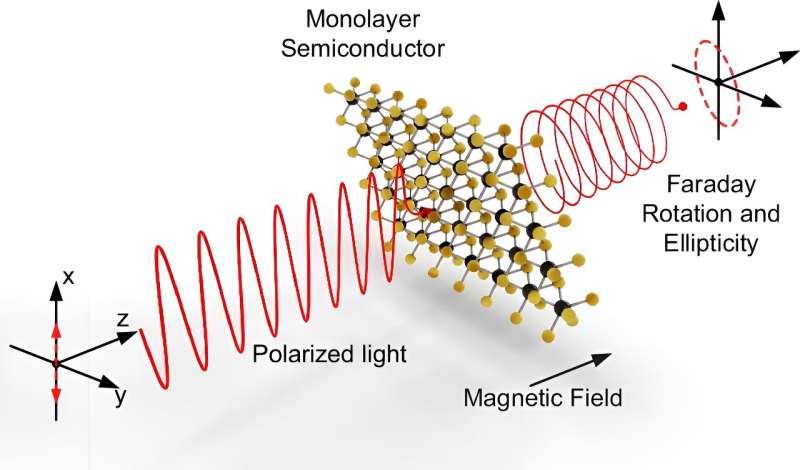Faraday effect in two-dimensional semiconductors. Credit: nature communications (2024). DOI: 10.1038/s41467-024-47294-5
It has been known for centuries that light exhibits wave behavior under certain circumstances. Some materials are able to rotate the polarization, or direction of oscillation, of light waves as light passes through them. This property is used in central components of optical communications networks called “optical isolators” or “photodiodes.” This component allows light to travel in one direction but blocks all light in the other direction.
In a recent study, German and Indian physicists showed that ultrathin two-dimensional materials such as tungsten diselenide can rotate the polarization of visible light by a few degrees at certain wavelengths under a small magnetic field suitable for use on a wafer.Scientists from the University of Münster in Germany and the Indian Institute of Science Education and Research (IISER) in Pune, India, published their findings in the journal Nature Communications.
One of the problems with traditional optical isolators is that they are quite large, with dimensions ranging from a few millimeters to a few centimeters. As a result, researchers have not yet been able to create miniaturized integrated optical systems on a wafer that are comparable to everyday silicon-based electronics. Current integrated optical chips consist of only a few hundred components on a wafer.
By comparison, a computer processor chip contains billions of switching elements. The work of the German-Indian team therefore takes a step forward in the development of miniaturized optical isolators. The 2D material used by the researchers is only a few atomic layers thick, making it a hundred thousand times thinner than a human hair.
Professor Rudolf Bratschitsch from the University of Münster said: “In the future, two-dimensional materials may become the core of optical isolators and enable on-chip integration for today’s optics and future quantum optical computing and communication technologies.”
Professor Ashish Arora of IISER added: “The bulky magnets required even for optical isolators can be replaced by atomically thin two-dimensional magnets.” This will significantly reduce the size of photonic integrated circuits.
The research team deciphered the mechanism responsible for this effect: When ultrathin materials are placed in a small magnetic field, bound electron-hole pairs (so-called excitons) in the two-dimensional semiconductor rotate the polarization of light very strongly.
“Performing such sensitive experiments on two-dimensional materials is not easy because the sample area is very small,” Arora said. The scientists had to develop a new measurement technique that was about 1,000 times faster than previous methods.
More information:
Benjamin Carey et al., Giant Faraday rotations in atomically thin semiconductors, nature communications (2024). DOI: 10.1038/s41467-024-47294-5
Provided by the University of Münster
citation: Study shows ultrathin 2D materials can rotate the polarization of visible light (April 22, 2024), Retrieved April 22, 2024, from https://phys.org/news/2024-04-ultra-thin-Dimension- materials-rotation.html
This document is protected by copyright. No part may be reproduced without written permission except in the interests of fair dealing for private study or research purposes. Content is for reference only.
#Study #shows #ultrathin #materials #rotate #polarization #visible #light
Image Source : phys.org
